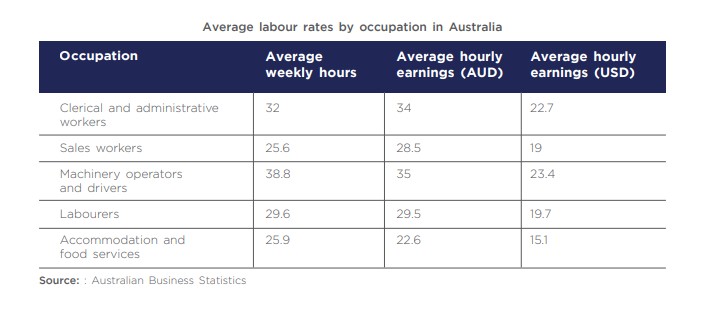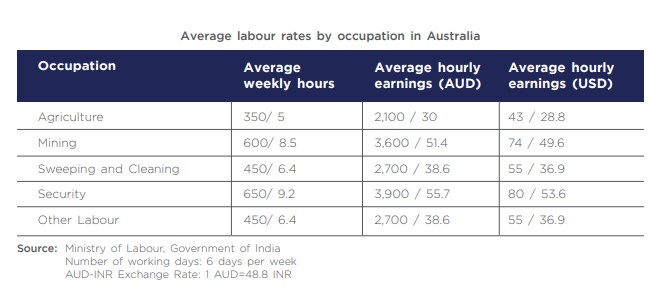Emerging Sectors
Labour intensive services

The demand for labour workforce in Australia is rising rapidly. Replacement demand in semi-skilled jobs is high due to Australia’s ageing working population. The average age of working population in Australia is close to 37 years452. The gap in workforce is also witnessed in occupations requiring low skill levels. Such occupations typically attract workers for
shorter period, thereby creating a continuous demand for new workers on the job.
The high labour wage rate in Australia is a deterrent for business owners to employ higher number of workers for semi-skilled jobs. The average wage for semi to low skilled jobs in Australia is approximately ~AUD 27 (USD 18) per hour453. In other developed countries like the US and the UK, the average wage for low skilled jobs is ~USD 14 and ~USD 13 (¤10) per hour, respectively454.
By 2020, Australian requirement for labour force is expected to reach 1.2 million and by 2030, Australia is likely to experience a shortage of 2.3 million workers455. Healthcare, agriculture and facility management are key sectors where Australia is currently facing a gap in skill requirement.
In comparison, India has an extensive workforce with a wide range of skills, especially in agriculture, healthcare and other semi-skilled jobs. The demography of Indian workforce is also young, with the average age of the Indian population reaching 29 years by 2020, compared with 40 in the US and 47 in Japan456. About 104 million people are expected to
join the Indian labour force by 2020457. In addition, vocational training programs initiated by the Government are also expected to provide a large trained workforce with semi-skilled jobs in numerous fields. India ‘s wage rates are also significantly lower.


Demand for agriculture workforce in Australia
In Australia, during 2011-16, there has been a decline in workers employed as livestock farmers (47%), crop farmers (28%) and mixed crop and livestock farmers (16%). Despite year-onyear increment of 4% in new agricultural job postings in Australia, the job posts remain unfulfilled. The vacant positions clearly indicate that despite availability of applications, the posts remain unoccupied due to lack of suitable skills.
India has a large workforce in agriculture. There has also been an emphasis on skill development in recent years, with organizations such as the Agriculture Skill Council of India (ASCI), which functions under the Ministry of Skill Development & Entrepreneurship (MSDE). These organizations have been working towards building and upgrading the skills of agricultural workers. Indian workforce can potentially meet the requirement generated
in Australia.
Demand in the facility management industry
Facility management services include cleaning, security, administration, catering services, etc... There is also a significant shortage of electricians and plumbers in Australia, particularly in New South Wales’ metropolitan areas and Western Australia’s regional areas. This demand is rising rapidly due to new infrastructure projects in Australia. Almost 35% of the job listings remain unfilled even after 60 days of job placement.458 There is thus a high demand with inadequate supply.
Indian labour workforce is already employed in various Middle-Eastern countries. In 2018, more than 300,000 workers were cleared by immigration to work in the Middle East. Australia has high demand for trade workers, technicians, labour, carpenters and masons. India can assist Australia with meeting its labour requirement.
Australia’s Medium and Long-term Strategic Skills List (MLTSSL) includes plumbers and electricians. To be eligible for foreigners to apply for a visa, they have to pass a skills assessment through Trades Recognition Australia (TRA), the appointed assessing authority in Australia for all trade workers. The Indian Government should work with Australian authorities to moderate norms for providing work visas for Indian workers to enable Indian labour force to meet the demand for these jobs in Australia.
The Covid-19 outbreak in early 2020 is likely to reduce the occupancy of physical office spaces, with public and private corporations gravitating towards digitization and virtual operations in the foreseeable future. However, there may also be a greater emphasis by corporations on sanitation and disinfection post the pandemic, which will result in an
increased demand for resources in the facility management industry.
Some of the facility management services present in both India and Australia are: G4S, SIS, Securitas and ISS. SIS is one of the largest security service companies in Australia. Facility management companies in India can tie up with Australian counterparts to provide economical labour to meet Australian demand.
Demand in the healthcare sector
Healthcare sector accounts for ~10% of the job postings in Australia, of which 30% are for nurses. Every year there is a 2.5% year-on-year growth in demand for midwifery and nursing professionals. The Australian Department of Health has projected a shortfall of 85,000 nurses by 2025, which is further expected to reach 123,000 by 2030459.
India has 2,958 institutions for general nurse midwives with an annual admission capacity of 118,406 students, 1,921 institutions for auxiliary nurse midwives with an annual admission capacity of 54,859.460 Indian nurses and midwives are currently working in various countries
like United Arab Emirates, Canada, Australia, European Continent, etc. In some parts of Australia, there is already a significant Indian population that works in the healthcare sector such as Alice Springs in the Northern territory.
The medical support in regional areas is deficient, and emergency services, as well as expert medical advice, particularly after work hours is poor.
India can assist Australia with its labour requirements
As the regional territories in Australia are becoming more urban, the demand for workers is continuously growing. There are Designated Area Migration Agreements (DAMA) across Australian states, which match overseas workers to requirements specific to regions in the country, in addition to the standard skilled migration programs. Such a program is established between the Government and a regional, state or territory authority. Through the scheme, two types of visas programs are available i.e. Temporary Skills Shortage (TSS) and Employer Nominated Scheme (ENS). Currently, there are seven DAMAs in place.[1] The benefit of DAMA over the previous migration program is the openness to semi-skilled labour migrants. This has been done to fill employment gaps in regional areas in Australia.
Recommendations
- Movement of semi-skilled workers from India to Australia can be encouraged by including
- India as a partner under the Designated Area Migration Agreements (DAMA) in Australia and by updating Australian visa norms for Indian workers.
- Indian personnel management and supply companies should tie up with Australian authorities and designated agencies to impart necessary job and language skills with certification in the required and specific areas of shortages in the Australian economy.
452 International Monetary Fund. World Economic Outlook - October 2018
453 IMF’s World Economic Outlook, October 2018
454 Australian Bureau of Statistics Cat. No. 5204.0 Table 5, Gross Value Added (GVA) by Industry, Chain volume measures
455 Australia to face a skill shortage of 2.3 million workers by 2030; June retail figures buck downward trend: Midday Roundup, smart company
456 Harnessing India’s Demographic Dividend through Skilling: Challenges and Way Forward, 2018, New Delhi Publishers
457 Imperfect skills programme no match for India’s army of workers, The Economic Times
458 Skill Shortage: Electricians in Australia
459 Is a Nursing Shortage Placing Australia’s Healthcare Sector at Risk? 2018, Hiring Lab Australia
460 India Short Of Nearly Two Million Nurses, NDTV
[1] Designated area migration agreements, Department of Home Affairs
Next topic: